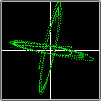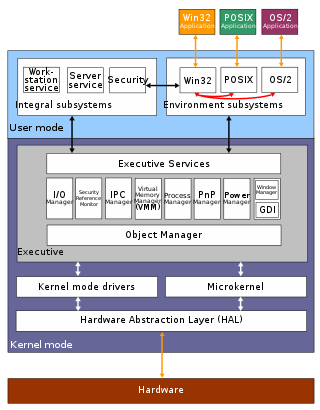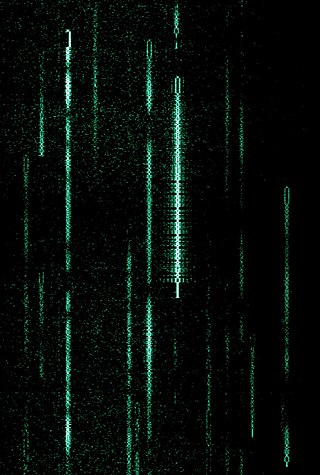
PSK63 (meaning Phase Shift Keying at a rate of 63 baud) is a digital radio modulation mode used primarily in the amateur radio field to conduct real-time keyboard-to-keyboard informal text chat between amateur radio operators.

PSK63 (meaning Phase Shift Keying at a rate of 63 baud) is a digital radio modulation mode used primarily in the amateur radio field to conduct real-time keyboard-to-keyboard informal text chat between amateur radio operators.
In April 2003, Skip Teller, KH6TY, the creator of Digipan, [1] requested an addition to Moe (AE4JY) Wheatley's PSKCore DLL to support the PSK63 mode. Subsequently, another mode - PSK125 - has been added to the PSKCore DLL. [2]
PSK63 is now supported directly in KH6TY's own QuikPSK software, as well as in Digipan, AA6YQ's WinWarbler, F6CTE's MultiPSK, AE4JY's WinPSK, HB9DRV's DM780, PSK31 Deluxe, MMVARI, Fldigi, MIXW, and DL4RCK's RCKRtty. It is also supported in hardware by the Elecraft KX3.
Others are likely to follow, now that version 1.17 of the PSKCore dll supports both PSK31 and PSK63. QuikPSK, MultiPSK and PSK31 Deluxe can decode up to 24 signals simultaneously. QuickPSK has a unique additional capability to send colour thumbnail pictures (32x32 pixel, 16 colours) using the PSK63 mode.
A PSK63-only version of the PSKCore dll is also available at KH6TY's web site for use with any software that uses PSKCore to implement PSK31. Simply by replacing the original PSKCore file (it is suggested that you rename the original rather than deleting it) with the new version, the PSK31 software supports PSK63 instead of PSK31.
This technique has been used during early experiments with the PSK63 mode, but it is not likely to continue to be very widely used now that software that supports PSK63 directly has become widely available.
The official distribution of the PSKCore DLL, which supports PSK31, PSK63, and PSK125, is available on Moe (AE4JY) Wheatley's website. [2]

Radioteletype (RTTY) is a telecommunications system consisting originally of two or more electromechanical teleprinters in different locations connected by radio rather than a wired link. Radioteletype evolved from earlier landline teleprinter operations that began in the mid-1800s. The US Navy Department successfully tested printing telegraphy between an airplane and ground radio station in 1922. Later that year, the Radio Corporation of America successfully tested printing telegraphy via their Chatham, Massachusetts, radio station to the R.M.S. Majestic. Commercial RTTY systems were in active service between San Francisco and Honolulu as early as April 1932 and between San Francisco and New York City by 1934. The US military used radioteletype in the 1930s and expanded this usage during World War II. From the 1980s, teleprinters were replaced by personal computers (PCs) running software to emulate teleprinters.

The Windows API, informally WinAPI, is the foundational application programming interface (API) that allows a computer program to access the features of the Microsoft Windows operating system in which the program is running.
In computing, the Windows Sockets API (WSA), later shortened to Winsock, is an application programming interface (API) that defines how Windows network application software should access network services, especially TCP/IP. It defines a standard interface between a Windows TCP/IP client application and the underlying TCP/IP protocol stack. The nomenclature is based on the Berkeley sockets API used in BSD for communications between programs.

PSK31 or "Phase Shift Keying, 31 Baud", also BPSK31 and QPSK31, is a popular computer-sound card-generated radioteletype mode, used primarily by amateur radio operators to conduct real-time keyboard-to-keyboard chat, most often using frequencies in the high frequency amateur radio bands (near-shortwave). PSK31 is distinguished from other digital modes in that it is specifically tuned to have a data rate close to typing speed, and has an extremely narrow bandwidth, allowing many conversations in the same bandwidth as a single voice channel. This narrow bandwidth makes better use of the RF energy in a very narrow space thus allowing relatively low-power equipment to communicate globally using the same skywave propagation used by shortwave radio stations.

7-Zip is a free and open-source file archiver, a utility used to place groups of files within compressed containers known as "archives". It is developed by Igor Pavlov and was first released in 1999. 7-Zip has its own archive format called 7z, but can read and write several others.
AX.25 is a data link layer protocol originally derived from layer 2 of the X.25 protocol suite and designed for use by amateur radio operators. It is used extensively on amateur packet radio networks.

WinRAR is a trialware file archiver utility for Windows, developed by Eugene Roshal of win.rar GmbH. It can create and view archives in RAR or ZIP file formats, and unpack numerous archive file formats. To enable the user to test the integrity of archives, WinRAR embeds CRC32 or BLAKE2 checksums for each file in each archive. WinRAR supports creating encrypted, multi-part and self-extracting archives.
Varicode is a self-synchronizing code for use in PSK31. It supports all ASCII characters, but the characters used most frequently in English have shorter codes. The space between characters is indicated by a 00 sequence, an implementation of Fibonacci coding. Originally created for speeding up real-time keyboard-to-keyboard exchanges over low bandwidth links, Varicode is freely available.
WinDbg is a multipurpose debugger for the Microsoft Windows computer operating system, distributed by Microsoft. Debugging is the process of finding and resolving errors in a system; in computing it also includes exploring the internal operation of software as a help to development. It can be used to debug user mode applications, device drivers, and the operating system itself in kernel mode.
AMTOR is a type of telecommunications system that consists of two or more electromechanical teleprinters in different locations that send and receive messages to one another. AMTOR is a specialized form of RTTY protocol. The term is an acronym for Amateur Teleprinting Over Radio and is derived from ITU-R recommendation 476-1 and is known commercially as SITOR developed primarily for maritime use in the 1970s. AMTOR was developed in 1978 by Peter Martinez, G3PLX, with the first contact taking place in September 1978 with G3YYD on the 2m Amateur band. It was developed on homemade Motorola 6800-based microcomputers in assembler code. It was used extensively by amateur radio operators in the 1980s and 1990s but has now fallen out of use as improved PC-based data modes are now used and teleprinters became out of fashion.
The booting process of Windows NT is the process run to start Windows NT. The process has been changed between releases, with the biggest changes being made with Windows Vista. In versions before Vista, the booting process begins when the BIOS loads the Windows NT bootloader, NTLDR. Starting with Vista, the booting process begins with either the BIOS or UEFI load the Windows Boot Manager, which replaces NTLDR as the bootloader. Next, the bootloader starts the kernel, which starts the session manager, which begins the login process. Once the user is logged in, File Explorer, the graphical user interface used by Windows NT, is started.
The Microsoft Windows operating system supports a form of shared libraries known as "dynamic-link libraries", which are code libraries that can be used by multiple processes while only one copy is loaded into memory. This article provides an overview of the core libraries that are included with every modern Windows installation, on top of which most Windows applications are built.

My Life Online (Mylo) was a device created and marketed by Sony for portable instant messaging and other Internet-based communications, browsing Internet web sites using the Opera web browser and playback and sharing of media files. The pocket-sized, tablet-shaped handheld device, which debuted in 2006, had a screen which slid up to reveal a QWERTY keyboard. The brand name 'Mylo' means My Life Online. Using Wi-Fi instead of cellular networks, the Mylo was targeted to the 18–24 age group.
The booting process of Microsoft Windows varies between different releases.
WSJT-X is a computer program used for weak-signal radio communication between amateur radio operators. The program was initially written by Joe Taylor, K1JT, but is now open source and is developed by a small team. The digital signal processing techniques in WSJT-X make it substantially easier for amateur radio operators to employ esoteric propagation modes, such as high-speed meteor scatter and moonbounce. Additionally WSJT is able to send signal reports to spotting networks such as PSK Reporter.
In computing on Microsoft platforms, WoW64 is a subsystem of the Windows operating system capable of running 32-bit applications on 64-bit Windows. It is included in all 64-bit versions of Windows, except in Windows Server Server Core where it is an optional component, and Windows Nano Server where it is not included. WoW64 aims to take care of many of the differences between 32-bit Windows and 64-bit Windows, particularly involving structural changes to Windows itself.
Codec 2 is a low-bitrate speech audio codec that is patent free and open source. Codec 2 compresses speech using sinusoidal coding, a method specialized for human speech. Bit rates of 3200 to 450 bit/s have been successfully created. Codec 2 was designed to be used for amateur radio and other high compression voice applications.

Fldigi is a free and open-source program which allows an ordinary computer's sound card to be used as a simple two-way data modem. The software is mostly used by amateur radio operators who connect the microphone and headphone connections of an amateur radio SSB or FM transceiver to the computer's headphone and microphone connections, respectively.

PSK Reporter is an amateur radio signal reporting and spotting network and website started by Philip Gladstone in 2014 which allows operators to see where their radio signals are being received. The platform works by collecting digital signal reports from software clients such as WSJT and FLDIGI, then mapping them to show which stations are being heard by other clients. The website takes its name from the popular amateur radio digital mode PSK31 and supports numerous digital modes, but now the vast majority of digital modes recorded by the service are FT8 traffic. Most traffic recorded on PSK Reporter is in the HF amateur radio bands but the platform also supports MF, VHF, and UHF bands. As of 2021 PSK Reporter had collected over 20 billion reception reports.